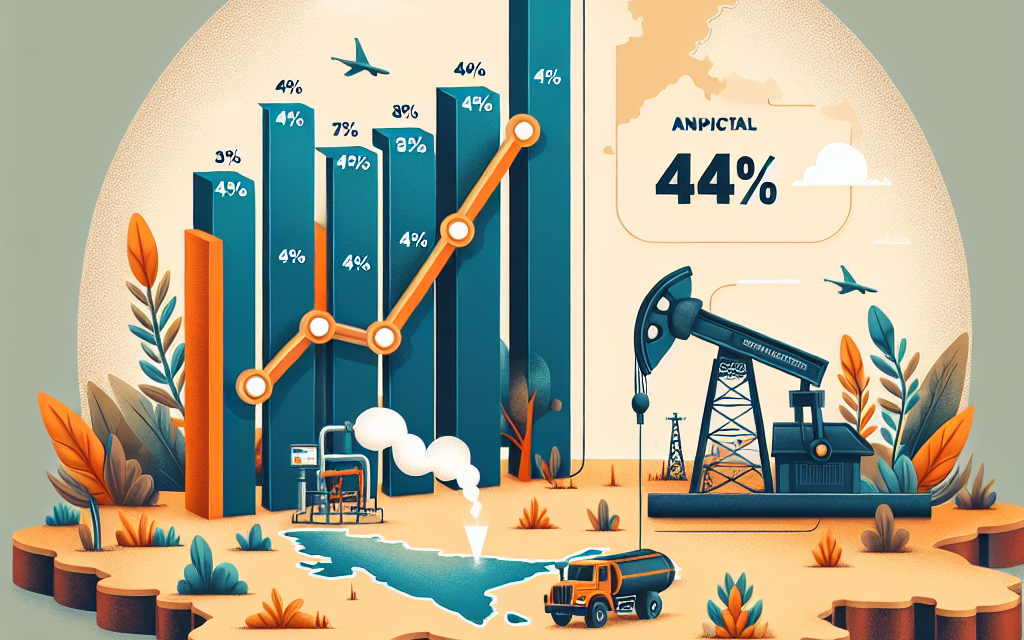“BP Set to Boost Oil Production by 44% from India’s Largest Field, Promising a New Era of Energy.”
Introduction
BP anticipates a significant 44% increase in oil production from India’s largest oil field, as reported by the Oil and Natural Gas Corporation (ONGC). This projection highlights BP’s commitment to enhancing energy output in the region, leveraging advanced technologies and strategic partnerships. The anticipated boost in production is expected to play a crucial role in meeting India’s growing energy demands and supporting the country’s economic development. This development underscores the importance of collaboration between international energy companies and local entities in optimizing resource extraction and ensuring energy security.
BP’s Strategic Plans for India’s Largest Oil Field
BP has set its sights on a significant expansion of oil production in India, particularly focusing on the country’s largest oil field, which is operated by the Oil and Natural Gas Corporation (ONGC). This ambitious initiative is expected to yield a remarkable 44% increase in oil production, a development that underscores BP’s commitment to enhancing its operational footprint in one of the world’s fastest-growing energy markets. The strategic plans laid out by BP are not merely about increasing output; they also reflect a broader vision of sustainable energy development and technological innovation.
To begin with, BP’s approach to the enhancement of oil production in this field is rooted in advanced technology and innovative practices. The company aims to leverage its expertise in digital technologies and data analytics to optimize extraction processes. By employing cutting-edge techniques, BP intends to improve efficiency and reduce operational costs, thereby maximizing the potential of the oil field. This technological infusion is expected to not only boost production levels but also ensure that the operations are conducted in an environmentally responsible manner, aligning with global sustainability goals.
Moreover, BP’s collaboration with ONGC is pivotal to the success of this initiative. The partnership is characterized by a shared commitment to harnessing the full potential of the oil field while adhering to best practices in safety and environmental stewardship. This collaborative effort is anticipated to foster knowledge exchange and capacity building, which are essential for navigating the complexities of oil extraction in a challenging environment. As both entities work together, they are likely to create a model for future partnerships in the energy sector, demonstrating how collaboration can lead to enhanced productivity and sustainability.
In addition to technological advancements and strategic partnerships, BP’s plans also encompass significant investments in infrastructure. The company recognizes that robust infrastructure is crucial for supporting increased production levels. Therefore, BP is poised to invest in upgrading existing facilities and developing new ones that can accommodate the anticipated rise in output. This investment not only aims to enhance operational efficiency but also seeks to create job opportunities and stimulate local economies, thereby contributing to the overall development of the region.
Furthermore, BP’s strategic plans are aligned with India’s broader energy goals, which include increasing domestic oil production to reduce dependence on imports. By ramping up production in the largest oil field, BP is playing a vital role in supporting India’s energy security. This alignment with national priorities is likely to foster a favorable regulatory environment, as the government is keen to encourage investments that contribute to energy independence and economic growth.
As BP moves forward with its plans, it is essential to consider the potential challenges that may arise. The oil and gas sector is inherently volatile, influenced by fluctuating global oil prices and geopolitical factors. However, BP’s extensive experience and strategic foresight position it well to navigate these uncertainties. By maintaining a flexible approach and adapting to changing market conditions, BP can ensure the sustainability of its operations and the success of its initiatives in India.
In conclusion, BP’s anticipation of a 44% increase in oil production from India’s largest field, as reported by ONGC, reflects a comprehensive strategy that integrates technology, collaboration, infrastructure investment, and alignment with national energy goals. This multifaceted approach not only aims to enhance production but also emphasizes sustainability and economic development, positioning BP as a key player in India’s evolving energy landscape. As the company embarks on this ambitious journey, it is poised to make a significant impact on both the local and national levels, paving the way for a more secure and sustainable energy future.
Impact of ONGC’s Projections on Global Oil Markets
The recent announcement by Oil and Natural Gas Corporation (ONGC) regarding a projected 44% increase in oil production from India’s largest field has significant implications for global oil markets. This projection not only highlights the potential for enhanced domestic energy security in India but also signals a shift in the dynamics of global oil supply. As ONGC prepares to ramp up production, the ripple effects on international oil prices and market stability are likely to be profound.
To begin with, the anticipated increase in production from ONGC’s field is expected to contribute substantially to India’s overall oil output. As one of the world’s largest consumers of oil, India has been striving to reduce its dependence on imports, which currently account for a significant portion of its energy needs. By boosting domestic production, ONGC aims to alleviate some of the pressures associated with fluctuating global oil prices, thereby enhancing energy security for the nation. This development is particularly timely, given the ongoing volatility in the global oil market, which has been influenced by geopolitical tensions, supply chain disruptions, and changing demand patterns.
Moreover, the increase in production from India’s largest oil field could lead to a recalibration of supply dynamics in the global market. As ONGC’s output rises, it may contribute to a more balanced supply-demand equation, particularly in the Asia-Pacific region. This shift could potentially ease some of the upward pressure on oil prices that has been observed in recent years. Analysts suggest that if India successfully increases its production as projected, it could lead to a decrease in reliance on oil imports from other regions, thereby altering trade flows and impacting the pricing strategies of major oil-exporting countries.
In addition to influencing supply dynamics, ONGC’s projections may also affect the investment landscape within the oil sector. Increased production capacity often attracts foreign investment, as companies seek to capitalize on the potential for higher returns. This influx of capital could lead to further advancements in technology and infrastructure, ultimately enhancing operational efficiency and sustainability within the industry. As global investors look for opportunities in emerging markets, India’s commitment to boosting its oil production could position it as an attractive destination for investment, fostering economic growth and job creation.
Furthermore, the anticipated increase in oil production from ONGC aligns with broader trends in the energy sector, where there is a growing emphasis on sustainability and the transition to cleaner energy sources. While oil remains a critical component of the global energy mix, the industry is increasingly under pressure to adopt more environmentally friendly practices. As ONGC ramps up production, it may also explore innovative technologies and practices that minimize environmental impact, thereby addressing concerns related to climate change and sustainability.
In conclusion, ONGC’s projection of a 44% increase in oil production from India’s largest field is poised to have far-reaching implications for global oil markets. By enhancing domestic production, India can bolster its energy security while potentially influencing global supply dynamics and pricing strategies. Additionally, this development may attract foreign investment and encourage advancements in sustainable practices within the oil sector. As the global energy landscape continues to evolve, ONGC’s initiatives will undoubtedly play a crucial role in shaping the future of oil production and consumption, both in India and beyond.
Technological Innovations Driving Increased Oil Production
In the ever-evolving landscape of the oil and gas industry, technological innovations play a pivotal role in enhancing production capabilities and optimizing resource extraction. BP’s recent announcement regarding a projected 44% increase in oil production from India’s largest field, as reported by the Oil and Natural Gas Corporation (ONGC), underscores the significance of these advancements. This anticipated surge in output is not merely a reflection of increased drilling efforts but rather a testament to the integration of cutting-edge technologies that are transforming the sector.
One of the foremost innovations driving this increase is the application of advanced seismic imaging techniques. These technologies allow for a more precise understanding of subsurface geology, enabling companies to identify potential oil reservoirs with greater accuracy. By utilizing high-resolution 3D seismic surveys, BP and ONGC can pinpoint the most promising drilling locations, thereby minimizing the risks associated with exploratory drilling. This strategic approach not only enhances the likelihood of successful extraction but also reduces the environmental footprint associated with unnecessary drilling activities.
Moreover, the implementation of enhanced oil recovery (EOR) methods has become increasingly prevalent in maximizing output from existing fields. Techniques such as water flooding, gas injection, and thermal recovery are being employed to extract additional oil that would otherwise remain trapped in the reservoir. BP’s commitment to leveraging these EOR technologies is indicative of a broader industry trend aimed at optimizing production from mature fields. By employing these methods, BP anticipates not only an increase in production volumes but also a more sustainable approach to resource management.
In addition to EOR, the integration of digital technologies is revolutionizing operational efficiency within the oil sector. The use of data analytics, artificial intelligence, and machine learning algorithms enables companies to monitor production processes in real-time, facilitating quicker decision-making and more effective resource allocation. For instance, predictive maintenance powered by AI can identify potential equipment failures before they occur, thereby minimizing downtime and enhancing overall productivity. This proactive approach to maintenance is particularly crucial in the context of large-scale operations, where even minor disruptions can lead to significant financial losses.
Furthermore, the adoption of automation and robotics in drilling operations is streamlining processes and reducing human error. Automated drilling systems can operate with precision and consistency, allowing for faster drilling cycles and improved safety measures. As BP anticipates increased production from India’s largest oil field, the role of automation in enhancing operational efficiency cannot be overstated. By reducing reliance on manual labor and minimizing the risks associated with human intervention, these technologies contribute to a more resilient and productive operational framework.
As BP and ONGC prepare to harness these technological advancements, it is essential to recognize the broader implications for the oil and gas industry. The anticipated increase in production not only signifies a boost for the companies involved but also reflects a growing trend towards innovation-driven growth in the sector. By embracing new technologies and methodologies, the industry is positioning itself to meet the evolving demands of global energy markets while simultaneously addressing environmental concerns.
In conclusion, the projected 44% increase in oil production from India’s largest field, as anticipated by BP, is a clear indication of how technological innovations are reshaping the oil and gas landscape. Through advanced seismic imaging, enhanced oil recovery techniques, digital technologies, and automation, the industry is poised to achieve greater efficiency and sustainability. As these innovations continue to unfold, they will undoubtedly play a crucial role in defining the future of oil production, ensuring that companies can meet both economic and environmental challenges head-on.
Environmental Considerations in Expanding Oil Production
As BP anticipates a significant 44% increase in oil production from India’s largest field, as reported by the Oil and Natural Gas Corporation (ONGC), it is essential to consider the environmental implications of such an expansion. The oil and gas industry has long been scrutinized for its impact on ecosystems, air quality, and climate change. Therefore, as production ramps up, it becomes crucial to evaluate the measures that can be implemented to mitigate potential environmental harm.
Firstly, the extraction and production processes associated with oil drilling can lead to habitat disruption. The expansion of drilling sites often necessitates the clearing of land, which can result in the loss of biodiversity. Consequently, it is vital for BP and ONGC to conduct thorough environmental impact assessments (EIAs) before commencing operations. These assessments should identify sensitive ecosystems and species that could be affected, allowing for the development of strategies to minimize disruption. For instance, implementing buffer zones around critical habitats can help protect wildlife while still allowing for oil extraction.
Moreover, the potential for oil spills poses a significant risk to marine and terrestrial environments. As production increases, so does the likelihood of accidents occurring during transportation and drilling. To address this concern, BP must invest in advanced technology and infrastructure designed to prevent spills and respond effectively should they occur. This includes utilizing double-hulled tankers, which are less prone to leaks, and establishing rapid response teams equipped to handle spills swiftly. By prioritizing safety measures, BP can significantly reduce the environmental risks associated with increased oil production.
In addition to the immediate risks of extraction, the long-term implications of fossil fuel reliance cannot be overlooked. The burning of oil contributes to greenhouse gas emissions, which are a primary driver of climate change. As global temperatures rise, the consequences for ecosystems and human societies become increasingly severe. Therefore, it is imperative for BP to align its production goals with broader climate commitments. This could involve investing in carbon capture and storage technologies, which can help offset emissions from oil production. Furthermore, BP should consider diversifying its energy portfolio to include renewable sources, thereby reducing its overall carbon footprint and contributing to a more sustainable energy future.
Transitioning to a more sustainable model does not only benefit the environment; it can also enhance BP’s reputation and market position. As consumers and investors become more environmentally conscious, companies that prioritize sustainability are likely to gain a competitive edge. By demonstrating a commitment to responsible production practices, BP can foster trust among stakeholders and potentially attract investment from those who prioritize environmental, social, and governance (ESG) criteria.
In conclusion, while the anticipated increase in oil production from India’s largest field presents economic opportunities, it is crucial to approach this expansion with a strong focus on environmental considerations. By conducting comprehensive EIAs, investing in spill prevention technologies, and aligning production strategies with climate goals, BP can mitigate the environmental impacts associated with increased oil extraction. Ultimately, a balanced approach that prioritizes both economic growth and environmental stewardship will be essential for the long-term sustainability of the oil and gas industry in India and beyond.
Economic Implications of Increased Oil Output in India
The anticipated 44% increase in oil production from India’s largest field, as reported by the Oil and Natural Gas Corporation (ONGC), carries significant economic implications for both the domestic and global markets. This surge in output is expected to bolster India’s energy security, reduce dependence on imports, and enhance the overall economic landscape of the nation. As the world’s third-largest consumer of oil, India has long grappled with the challenges posed by fluctuating global oil prices and the need for a stable energy supply. Therefore, the increase in production from this key field could serve as a pivotal moment in addressing these challenges.
Firstly, the rise in oil production is likely to lead to a decrease in India’s reliance on imported crude oil. Currently, India imports approximately 85% of its crude oil requirements, making it vulnerable to international price volatility and geopolitical tensions. By increasing domestic production, India can mitigate some of these risks, thereby fostering a more stable economic environment. This shift not only enhances energy security but also has the potential to positively impact the trade balance. A reduction in oil imports could lead to a decrease in the current account deficit, which is crucial for maintaining the stability of the Indian rupee and overall economic health.
Moreover, the increase in oil output is expected to stimulate job creation and investment in the energy sector. As production ramps up, there will be a corresponding need for skilled labor, technology, and infrastructure development. This could lead to a multiplier effect, where increased employment opportunities in the oil sector also benefit ancillary industries, such as transportation, logistics, and manufacturing. Consequently, the overall economic activity in regions surrounding the oil field may experience a significant boost, contributing to local and national economic growth.
In addition to job creation, the anticipated increase in oil production could attract foreign investment. Global energy companies may view India’s expanding oil sector as an attractive opportunity, leading to increased capital inflow. This influx of investment can further enhance technological advancements and operational efficiencies within the industry, ultimately benefiting the economy at large. Furthermore, as India positions itself as a more self-sufficient energy producer, it may enhance its bargaining power in international energy markets, potentially leading to more favorable trade agreements and partnerships.
However, it is essential to consider the environmental implications of increased oil production. While the economic benefits are substantial, the potential for environmental degradation and climate change must not be overlooked. The Indian government and ONGC will need to implement sustainable practices and invest in cleaner technologies to mitigate the environmental impact of increased oil extraction. Balancing economic growth with environmental stewardship will be crucial in ensuring that the benefits of increased oil production do not come at the expense of ecological health.
In conclusion, the projected 44% increase in oil production from India’s largest field presents a multifaceted opportunity for economic advancement. By reducing reliance on imports, stimulating job creation, and attracting foreign investment, this development could significantly enhance India’s economic landscape. However, it is imperative that these advancements are pursued with a commitment to sustainability, ensuring that the benefits of increased oil output contribute to a resilient and environmentally responsible economy. As India navigates this pivotal moment, the interplay between economic growth and environmental responsibility will shape the future of its energy sector and overall economic trajectory.
The Role of BP in India’s Energy Transition
BP’s involvement in India’s energy landscape is increasingly significant, particularly as the country seeks to balance its growing energy demands with a commitment to sustainability. The recent announcement by the Oil and Natural Gas Corporation (ONGC) regarding a projected 44% increase in oil production from India’s largest field underscores the pivotal role that BP plays in this transition. As a global energy company, BP is not only focused on traditional oil and gas production but is also actively investing in renewable energy sources and technologies that align with India’s long-term energy goals.
In recent years, India has emerged as one of the fastest-growing energy markets in the world, driven by rapid industrialization and urbanization. This surge in energy demand presents both challenges and opportunities for companies like BP. By collaborating with ONGC, BP is positioned to enhance oil production while simultaneously exploring avenues for cleaner energy solutions. This dual approach is essential, as it allows BP to contribute to immediate energy needs while also supporting India’s ambition to reduce its carbon footprint.
Moreover, BP’s commitment to sustainability is evident in its strategic investments in renewable energy projects across India. The company has been actively involved in developing solar and wind energy initiatives, which are crucial for diversifying the energy mix and reducing reliance on fossil fuels. By integrating renewable energy into its portfolio, BP not only addresses the pressing issue of climate change but also aligns itself with the Indian government’s vision of achieving a significant share of renewable energy in the national grid.
Transitioning to a more sustainable energy future requires innovation and collaboration, and BP is leveraging its technological expertise to drive this change. The company is investing in advanced technologies that enhance energy efficiency and reduce emissions in oil and gas operations. For instance, BP’s focus on digitalization and data analytics enables more efficient resource management, which is vital for optimizing production while minimizing environmental impact. This technological advancement is particularly relevant in the context of India’s energy transition, as it allows for a more sustainable approach to meeting the country’s energy needs.
Furthermore, BP’s role extends beyond production and technology; it also encompasses capacity building and knowledge sharing. By partnering with local stakeholders, BP is helping to develop the skills and expertise necessary for a sustainable energy sector. This collaborative approach not only fosters local economic development but also ensures that the workforce is equipped to navigate the complexities of a rapidly evolving energy landscape.
As India continues to pursue its energy transition, the partnership between BP and ONGC will be instrumental in achieving a balanced approach to energy production. The anticipated increase in oil production from India’s largest field is a testament to the potential for growth in the sector, but it must be accompanied by a commitment to sustainability. BP’s proactive stance in integrating renewable energy and advanced technologies into its operations reflects a broader understanding of the need for a holistic approach to energy management.
In conclusion, BP’s role in India’s energy transition is multifaceted, encompassing traditional oil production, renewable energy investments, technological innovation, and capacity building. As the country navigates its energy future, BP’s contributions will be vital in ensuring that India can meet its energy demands while also making significant strides toward sustainability. The collaboration between BP and ONGC not only highlights the potential for increased production but also underscores the importance of a comprehensive strategy that prioritizes both energy security and environmental responsibility.
Future Prospects for Oil Production in the Indian Subcontinent
The Indian subcontinent is poised for a significant transformation in its oil production landscape, particularly with the recent announcement from BP regarding a projected 44% increase in oil output from India’s largest field, as reported by the Oil and Natural Gas Corporation (ONGC). This development not only underscores the potential of India’s hydrocarbon resources but also highlights the strategic partnerships that are essential for unlocking these reserves. As global energy demands continue to rise, the Indian oil sector is increasingly viewed as a critical player in meeting both domestic and international needs.
The anticipated increase in production is expected to stem from enhanced recovery techniques and advanced technologies that BP plans to implement in collaboration with ONGC. These innovations are crucial, as they can significantly improve the efficiency of oil extraction processes, thereby maximizing output from existing fields. Furthermore, the partnership between BP and ONGC exemplifies a growing trend in the energy sector, where collaboration between international oil companies and national oil corporations is becoming increasingly vital. Such alliances not only bring in technical expertise but also facilitate the sharing of best practices, which can lead to more sustainable and environmentally friendly extraction methods.
In addition to technological advancements, the geopolitical landscape of the Indian subcontinent plays a pivotal role in shaping the future of oil production. With the region’s strategic location and its proximity to major energy markets, India is well-positioned to become a key player in the global oil supply chain. As countries around the world seek to diversify their energy sources, India’s vast reserves present an attractive opportunity for investment and collaboration. This is particularly relevant in the context of the ongoing energy transition, where traditional fossil fuels are being scrutinized, yet remain essential for meeting immediate energy needs.
Moreover, the Indian government’s proactive approach to energy policy is likely to further bolster oil production in the coming years. Initiatives aimed at enhancing exploration and production activities, coupled with regulatory reforms, are designed to attract foreign investment and stimulate domestic production. The government’s commitment to achieving energy security and reducing dependence on imports aligns with the broader goals of economic growth and sustainability. As a result, the Indian oil sector is expected to witness increased activity, with new projects and investments emerging to capitalize on the country’s untapped potential.
As BP’s projections materialize, the implications for the Indian economy could be profound. An increase in oil production not only has the potential to enhance energy security but also to create jobs and stimulate economic growth in related sectors. The ripple effects of such developments can be felt across various industries, from transportation to manufacturing, thereby contributing to a more robust economic framework. Furthermore, as India continues to navigate the complexities of energy transition, the balance between fossil fuel production and renewable energy development will be crucial in shaping a sustainable future.
In conclusion, the anticipated 44% increase in oil production from India’s largest field, as indicated by BP and ONGC, marks a significant milestone for the Indian subcontinent’s oil sector. With the convergence of technological advancements, strategic partnerships, and supportive government policies, the future of oil production in India appears promising. As the country positions itself as a key player in the global energy landscape, the developments in its oil sector will undoubtedly have far-reaching implications for both the economy and energy security in the region.
Q&A
1. **What is the anticipated increase in oil production by BP from India’s largest field?**
– 44%
2. **Which company is BP collaborating with for this increase in oil production?**
– Oil and Natural Gas Corporation (ONGC)
3. **What is the significance of this increase in production for BP?**
– It enhances BP’s position in the Indian energy market and contributes to its overall production goals.
4. **What is the name of India’s largest oil field involved in this production increase?**
– The specific name of the field is not provided in the question.
5. **When is BP expecting to achieve this increase in oil production?**
– The exact timeline is not specified in the question.
6. **How does this increase in production align with global energy trends?**
– It reflects a growing focus on maximizing output from existing fields amid fluctuating global oil prices.
7. **What impact could this production increase have on India’s energy sector?**
– It could enhance domestic oil supply, reduce dependence on imports, and contribute to energy security.
Conclusion
BP’s anticipation of a 44% increase in oil production from India’s largest field, as reported by ONGC, highlights the potential for significant growth in the region’s energy sector. This development not only underscores BP’s commitment to expanding its operations in India but also reflects the country’s strategic importance in the global oil market. The increase in production could enhance energy security, drive economic growth, and contribute to meeting rising domestic and international energy demands.





